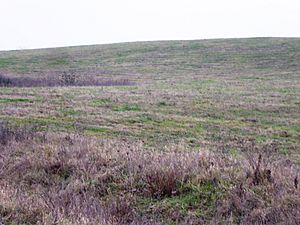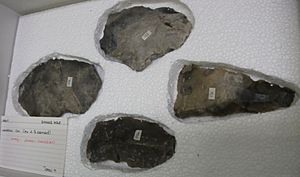Baker's Hole facts for kids
| Site of Special Scientific Interest | |
 |
|
| Area of Search | Kent |
|---|---|
| Interest | Geological |
| Area | 6.9 hectares (17 acres) |
| Notification | 1989 |
| Location map | Magic Map |
Baker's Hole is a special place in Kent, England. It covers about 6.9 hectares, which is roughly the size of 17 football fields! This area is known as a Site of Special Scientific Interest because of its important geology.
Most of Baker's Hole used to be a large quarry. People dug here for materials like Portland cement. But what makes it truly special are the amazing Stone Age tools found there. These tools tell us a lot about ancient humans who lived in Britain a very long time ago. Many of these important finds are now kept in museums around the world.
Where is Baker's Hole?
Baker's Hole is located in the Ebbsfleet valley in Kent. This area, south of the River Thames, is famous for many important Stone Age sites. For example, Swanscombe Heritage Park is nearby.
The site is traditionally described as being in Northfleet. However, it is now part of the "Swanscombe and Greenhithe" parish. For many years, a company called Associated Portland Cement Manufacturers Ltd. quarried here. Today, most of the quarrying has stopped. Much of the site has been filled in.
Discovering Ancient Tools
Baker's Hole is considered one of the most important sites in Britain for tools from the Early Middle Paleolithic period. This was a time when early humans, probably Neanderthals, lived here. They made many stone tools using a method called the Levallois technique.
Archaeologists found many large stone cores and flakes. These were the leftover pieces from making tools like hand axes. It was like a "factory" for stone tools! Over time, different types of tool-making styles were used here. These include the Clactonian, Acheulian, and Mousterian styles.
The first discoveries in the Ebbsfleet valley happened in 1881. A local amateur archaeologist named James Cross started collecting finds from the "Southfleet Pit" area of the quarry around 1909. Later, an archaeologist from the British Museum, R.A. Smith, published information about these finds in 1911.
The quarry workers were paid to hand in any tools they found. By 1914, about 750 pieces were transferred to the British Museum. The museum then shared smaller collections with other local museums. Today, the British Museum still holds 299 pieces from this original collection.
It's important to know that not all the tools found were from the same time period. For example, the hand axes might have been made at a different time than the cores and flakes. This makes studying the site even more interesting for archaeologists.
Can You Visit Baker's Hole?
No, Baker's Hole is on private land. This means it is not open to the public.


